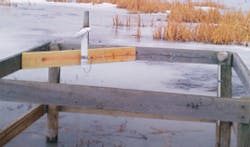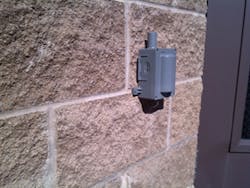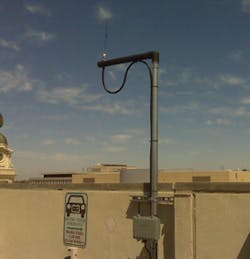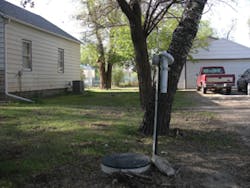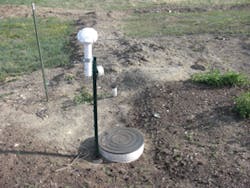For the past decade, the question of whether to choose drive-by or fixed-network has always tacitly assumed meter reading in an urban or suburban milieu, where 95% or more of all meters and customers dwell. But driving outside the city limits to farm country and open spaces, one finds a setting that, logistically, is almost like another planet. Urban communications infrastructure—microwave towers and phone lines—begin to thin out here, until, scores or hundreds of miles into the boonies, they are simply gone.
While some rural water users cluster in any of the thousands of tiny country towns, even beyond their borders outliers reside or do business miles into the Outback, many busily drawing surprising volumes of water (millions of gallons) for things like petroleum fracking and agribusiness.
In this relative isolation, too, one finds a patchwork of legacy systems composed of private water rights or water co-ops, federal management agencies, and mom-and-pop government townships—each with its own way of water delivery.
Datamatic’s Mosaic Firefly networking gateway uses a Web-based control panel.
The staffing of skilled jobs presents still another significant difference between urban and rural water works. Bill O’Connell, who served 12 years as a source water specialist for the Montana Rural Water Association (MRWA), remembers “one town [of 500 people] where the mayor, fire chief, public works department, and wastewater department manager were all the same guy. In much of rural America,” he says, “it’s not uncommon that a walk-by meter reader is the utility department. They read the meters, then do the billing and collect the revenues. They dig the graves; they fill the potholes. A huge chunk of time is absorbed with meter reading—and they often miss a month.”
MRWA numbers nearly 400 member agencies, averaging only about 500 or so meters apiece, he adds. It’s a niche, which, like most other rural utilities, doesn’t exactly lend itself to economies of scale.
Besides these challenges, other facets pestering would-be automatic meter reading (AMR) gigs include exposure to extreme weather in remote places (tornados, deep freezing, lighting) untended vegetation that hides meter locations, lack of paved surface access, and very long distances between meters. Wide-open Montana (the nation’s fourth largest state)–like many other remote areas–also presents radio-signal barriers due to its hilly terrain.
Still another perennial hurdle: tiny towns and hamlets managing tiny budgets. “And changing water rate
Towers and transmitters create the AMR matrix.
structures is really tough,” says O’Connell. “They are operating on a shoestring. You have to go through volunteers or ask a little utility board for more.”
Board members often try to get elected on the promise of slashing fees. There’s also high turnover “and a constant education process involved to get people to understand the true cost of water delivery.” The role of metering per se “is very under appreciated.”
More positively, though, if the funds for AMR can somehow be scrounged up and a system put up, the operational impact can be spectacular. Relieving an over-worked, leg-weary meter inspector has the effect of doubling or tripling the labor force. “They go from spending their week on [meter] reading, and now do other tasks for the city,” he explains.
All in all, the countryside is ripe with opportunity for project developers. “I’m excited about the potential,” O’Connell says.
Due east of Montana are the similarly low-density states of North and South Dakota. The latter’s total population barely tops 800,000, notes Dennis N. Davis, executive director the state’s Rural Water Association. Yet, as he explains, due to the state’s extraordinary water delivery system, it is fairly crying out for quality metering and automation. For one thing, well water is often hot and highly mineralized, poor in quality, and found extremely deep underground, making self-sufficiency unattractive. Some years ago, with the advent of affordable plastic piping, the state embarked ambitiously on tapping the Missouri River and distributing the resource statewide.
“It’s a fabulous source,” he says. “We put in water intakes, nice-sized water treatment, and pumps where needed.” A huge network of hundreds of miles of piping now pumps clean, treated water to about two-thirds of Dakota townships.
As for cost-recovery through meters, the problem here is the state’s unbelievably low density: Statewide the average ranges from a high of four or five water meters per square mile to less than one meter per square mile. And this doesn’t even begin to consider the region’s remote and isolated Native American reservations.
Some AMR has been phased-in slowly for South Dakota’s few urban areas. Davis believes Fixed networks seem favored, because one or two collectors mounted on water towers “can read a whole town.” Conversely, drive-by AMR is daunting. “If you’ve got 2,000 meters in rural South Dakota, you might have 2,000 miles to drive, or possibly more,” he says, going on to explain that many rural water agencies simply let customers read and report their own meters.
But the AMR story for the Great Plains is about to have a happy ending, it seems: an entirely new solution is now being applied in 2012.
More on that below. But first, in order to better appreciate the efforts being taken to do rural AMR, here’s a quick look at several important and creative innovations that vendors have recently been offering.
Drive-by or fixed? It’s the abiding question when transitioning from in-person, walk-by meter inspections, to AMR.Drive-by refers of course to equipping meters with small radio transmitters; then each car in the fleet gets an antenna, receiver, and laptop or other data storage device.
Thus equipped, drivers fan-out through customer neighborhoods, harvesting signals. It’s “bills on wheels.”
This happens almost infinitely easier and more quickly and with fewer snarling dogs to face, than was ever doable afoot.
Fixed-network describes an even more automated, hands-free AMI. This does away with in-person inspectors, on foot or wheels, by daisy-chaining data back to the billing office via radio and/or cell tower relays.
The First Satellite Reader
A new approach is currently being developed specifically for remote services in the hinterlands of the Great Plains. It’s being piloted and launched this year at the West River/Lyman-Jones Rural Water Service Inc., a private not-for-profit corporation based in Murdo, SD (population 488).
Called the Harmony Water Management System and, for its Web interface, the Harmony Cloud, its developer is Informational Data Technologies LLC (IDT), of Watertown, SD. IDT Executive Vice-President Angelo Polsinelli outlines its capabilities.
Harmony uses neither radio nor cell signals, towers, or repeaters. There’s no driving by, no daisy chain. Rather, its transmission points straight up from each meter–to a geostationary satellite overhead.
“Any major water meter brand” is adaptable, says Polsinelli. As with other typical AMR retrofits, each meter will be equipped with a battery-powered reader and transmitter.
The big difference about Harmony comes in its dedicated satellite uplink. It’s angled for a clear view above, and, assuming this is achieved, it can be expected to work, “even if stuck down a deep pit or valley or boxed off,” or miles from any other structure.
“All it needs is a clear line of sight to the sky,” says Polsinelli.
Two-way control is achieved via a Web browser. Data is formatted and displayed for water management; typical services would include things like “zone based daily loss detection . . . trending and history per meter, usage profiles, hydraulic studies, and, of course, billing,” says Polsinelli.
Data can be output to spreadsheets. Meters are addressable, and the system is Advanced Metering Infrastructure (AMI) compliant.
Battery life-cycle is again similar to that of other AMR, being sufficient, in this case, for 3,650 reads. Tapped daily, that’s 10 years of readings.
IDT began developing the Harmony about six years ago, after the company heard repeated complaints from water departments about being left out of the AMR/AMI boom by the inadequacy of the pervasive radio and cell systems. IDT’s solution ultimately came about, as Polsinelli recounts, when the firm “made a deal with the largest satellite company in the world. . . . The same system that tracks shipping containers worldwide . . . so it covers the entire globe,” even where no cell towers or landlines go.
As just noted, IDT’s first customer, West River/Lyman-Jones Rural Water Service, has been wowed by its performance so far. The agency’s general manager Jake Fitzgerald says, “There’s no better tool for water conservation in our area. We know our daily water loss in each sub-area of our entire service area [and] daily situation at each meter. And we are providing better service to our members,” he adds, because “we no longer must rely on them to read their own meters” and mail their results to the office each month.
“We basically administer all the billing within our office now,” he continues. “We were never able to do that before.”
A two-month test of leak detection capabilities produced spectacular results, and he reports that, to date, “We have notified customers of over 50 leaks on the user side of the meter.
“We have quite a few of those examples: On one of our first ones we had a meter that alarmed and used 20,000 gallons in a 24-hour period,” relates Fitzgerald. “The customer was notified, and then found that [piped] water was backfeeding into his well. So, it wasn’t a leak. Nothing was surfacing on the ground, but water was going back into well.” The loss might have gone undetected for weeks, but for the Harmony.
On another occasion, he continues, “A rancher’s pasture tap had used 14,000 gallons in a 24-hour period. He discovered that a calf had gotten in and broken one of his floats on his livestock tank.
Fitzgerald found 30 leaks ranging from 4,000 up to 42,000 gallons per day.
He sums up: “We’re all pretty excited.”
Fixed Networking, Almost Ready-Made
Hexagram is an automated meter-reading company “that’s been around since the beginning of AMI,” says Nancy Talley, a marketing communications manager for Hexagram’s Aclara AMI product, “because we are only AMI.”
What’s of prime interest for rural departments, she says, is Aclara’s Star Network system, which emits meter reads in tiny, battery-conserving bursts. Signals go to carefully positioned data collectors (as with any AMI). Using the cell phone network, collectors relay data to the water office. Integrated software parses it for billing and whatnot.
Data collector sites are positioned to provide redundancy, “so if you lose one of them you’re not losing all your meter readings,” says Talley.
The signal frequency falls in a private-license bandwidth from 450 to 475 MHz that’s “better able to carry through obstacles like brick walls,” she says. “A lot of water meters are in basements or pits, and we need a strong enough signal to send out of those places.”
Transmissions typically happen four times daily in millisecond shots. Given that high efficiency, the Aclara promise an exceptional 20-year battery life cycle on every meter.
What serves rural needs in particular are two key features, she says. One is the Star’s wide reach: daisy chaining enables ranging out to several miles. The second is its recently added two-way meter capability.
“You can send signals to meters that will allow you to pull a synched reading off the entire system and send it back to the utility,” she explains, noting that such readings can be used, for example, for doing water balances.
Drive-By Still Rules
Ian MacLeod, vice president of marketing for Master Meter, argues the case for drive-by AMR as the better option for rural systems.
“Basically, it’s the easiest,” he says. “It is very well understood, and this is a strong point.”
Rural agencies are often run by “mom-and-pop”-type staff, “who don’t go in for technological sophistication and don’t have time for extensive training,” he adds. Drive-by AMR does away with the big price tag of AMI and the skills set needed for ongoing maintenance.
Drive-by “is more like plug-and-play, out of the box, ready to go,” he says. Unlike AMI, “There are no wires, no interconnections. Everything is integrated in the meter. Drop it in the ground; plug it in . . . put a magnetic-mount antenna on the car roof, and you’re reading meters.
“Drive-by is extremely proven, mature technology that is stable and cost effective,” continues MacLeod. It is especially more doable “in a difficult economy when it’s hard to secure and justify the funds.”
Technology-wise, Master Meter uses what it calls an Interpreter, or universal AMR register. This replaces the original register in an existing meter. The Interpreter integrates an antenna transmitter, encoder, register, and battery under the meter glass, he says. Once turned on it begins transmitting via the 3G mobile system.
Data reading intervals are configurable down to the minute. A total of 4,000 data points can be taken per meter battery. A meter clock “enables synchronizing reads, so you know exactly how much water you produced and how much you measured,” he says.
A Multitasking Mosaic
According to Datamatic CEO Ken Kercher, the company’s Mosaic can also turn existing battery-equipped
Water meter satellite up-link signal for WR/LJ Water District, based in Murdo, SD, can penetrate tree cover. The agency’s newly installed satellite AMR is the first of its kind for water meters. It was developed by Informational Data Technologies LLC, of Watertown, SD.
meters into networked, integrated two-way transmission nodes. Mosaic transforms existing meters into networkable components by using a device called the Firefly. In effect, each meter gets retrofitted to make it both a reader and transmitter. The Firefly “basically sticks on the glass of the meter like a barnacle,” he says. “You just slap it on, and it picks up the readings.”
Pulse data and/or encoder readings are translatable/transmissible as well.
Water usage data is gathered and passed to neighboring Firefly meter-nodes. This forms a chain of potentially hundreds of intercommunicating meters, perhaps spanning a distance of many miles.
To reach the remotest water customers, Firefly repeaters (transmitters without meters) can be added. “So, going down a country road, you might have a meter or repeater every few hundred yards,” he explains. In designing with repeaters a client would weigh the cost of these versus, say, simply driving a few extra meter reading miles every month.
Collection points relay data packs to the home base. This can happen any number of ways, including: cell phones (as with Aclara), drive-by, fiber optic, coax cable, Ethernet, satellite dish, hybrids of several, and even with isolated, solar powered stations.
“Whatever it takes to get it to the Internet,” he says. Software sorts and saves the influx.
Self-Recharging Battery
All AMR/AMI systems share a common major limitation: their dependency on batteries. Each system must frugally manage tradeoffs between energy-eating functionality and battery longevity. Newly arriving on the field is a product touted as the first self-recharging battery. Called the IntelliH2O, it promises to output a power surplus. Instead of batteries posing limits on data reads, the self-powered meter alternative should yield water data and management benefits never imaginable before.
Scott Richardson, CEO of Capstone Metering in Carrollton, TX (which makes the IntelliH2O), describes his product as a full-featured, high-end, wireless, remote-control-capable water meter, capable of gathering data on flow, temperature, and pressure; detecting leaks or ruptures; sending alarms; and turning off quickly in an emergency.
For communications, the meter uses a standard Zigbee and 900 MHz. (There are also Wi-Fi and cellular modules.) Where it differs is the integrated recharger, which harnesses water flow to drive a tiny generator and thus sustain battery power virtually indefinitely.
How much power?
Well, a toilet flushed six times daily would probably yield enough to transmit all the conventional readings that a metering agency now wants, Richardson says. Or, take the average total water usage per home. This often reaches or exceeds about 2,500 gallons per month. At this volume, the IntelliH2O could probably transmit, additionally, constant readings of water pressure and temperature. Two-way communication would be fully powered as well.
Such abundance presents all kinds of possibilities. For one example: In 2011, a pilot project in Ponca City, OK (population about 25,000) found that Capstone Metering’s rechargeables can be used for constantly measuring and even controlling water pressures. Maintaining steady pressure is critical for water efficiency; flows exceeding 60 psi will be wasteful; flows less than 30 psi will impair delivery.
Another benefit is the ability to monitor temperature. Improvement here should help protect pipes from freezing, as a fully powered meter can send warnings whenever water nears the freezing point. Spigots can then be opened remotely to avoid damage.
Tips on Transitioning
To wrap up our country jaunt, Don Jackson, operations manager of the Woodruff-Roebuck Water District in Woodruff, SC (population about 4,000) offers hard-won bits of advice on rural AMR. He’s had experience with Orion’s drive-by, Master Meter’s 3G system, and Hersey Meter’s Hot Rod AMR.
Jackson’s district launched its drive-by AMR 10 years ago, before his arrival. When he came he soon found that the staff hadn’t even been given AMR training and were learning on the job. He immediately “got the meter readers going to school,” he recalls. This introduction to how easy it is to make mistakes here, inspired his chronicle of well-considered lessons.
Start By Assessing Your Meters
In the rush to automate, meters are easily overlooked. Better to step back and be sure they’re measuring well before you blast off. Evaluate possible weaknesses: register inaccuracy, low-flow performance, incorrect sizing, warranty provision, age, and condition. Any deficiencies will complicate the AMR implementation, and meter flaws tend to be magnified after AMR, due to the loss of future visual inspection visits.
Another under-appreciated vulnerability: customers, when notified of the impending wireless meter reading transition, are sometimes tempted, he says, “to be “˜smart’ and cut any exposed wires,” thinking that this will disable antennas or readings.
Still another chronic meter problem is invasion by ants or damage by rats. Again, pestilence will likely be missed after AMR installation. If possible, harden meters in advance.
Likewise, mark the meter locations, because, months and years after installing AMR, it’s surprisingly hard just to find them for servicing and maintenance, he says.
Lastly, this year and next are particularly good times to assess meters, because a new federal standard for lead-free components takes effect January 1, 2014. As funding may be needed, this might be the time to tack-on a request for AMR money, too.
Buy AMR Independently
If you favor one meter brand, don’t make the mistake of automatically embracing its AMR system complement. While the AMR must, of course, be compatible, it’s not uncommon that better AMR solutions are sold as a different make, he says.
Also, when shopping for AMR features and tools, he thinks data logging is one of the most powerful. You’ll find it useful for refuting not-uncommon customer complaints of overcharging after AMR turns on, and for leak detection.
Include Everyone in Decisions
Buying AMR “is a big deal,” and, typically, “The choice is handed down by upper management after a hearing sales pitch.”
Meanwhile, “The office and billing personnel are left out” or given just a superficial say.
This, he warns, will bring disaster. “Everybody in the department should be involved in the specs, from the general manager to the safety director, billing operation side, and meter readers,” he believes.
Involving line staff will inspire their buy-in, and stir greater effort to see the system succeed. Ignore them at your peril.
Scrutinize Contracts and Compatibility Issues
Bad deals for obsolete wares, fine print, hidden pitfalls, low-ball bid practices, bait-and-switch, the sole-source trap–all of these can come into play in contracting for expensive tech systems. Examine contract terms with a fine-toothed comb, Jackson advises. “Ask them things like “˜how frequent are software upgrades and what will they cost?’ Likewise with hardware and warranties.”
Also, consider how you’ll correct a bad deal if the system isn’t working up to expectations. Do you have an easy escape? Or are you locked in?
Visit Other Installations
Look at “sister systems” already running the AMR you’re considering. Again, don’t just talk to the manager there, because “He’s spent a million or two, and will never admit: “˜I screwed up; this thing is not working,'” says Jackson.
Rather, “Bring along your own meter readers, billing clerks, and operations–people” to talk candidly with their counterparts. “Ask the guy in the meter department, how are the meters performing? Are they failing? What’s the percentage of no reads? Are customers damaging them?”
Drive-By, or Fixed Network?
Jackson’s strong opinion here: “Start with drive-by. It’s great for rural [installations].”
Conversely, AMI is costly and hard to justify for a rural water district.
However, the ideal drive-by AMR should be upgradable to AMI for the sake of largest-volume customers. Jackson reports that Woodruff-Roebuck is planning a limited AMI setup for a couple of its biggest users; the hourly reads will be invaluable and worth the investment.
Jackson suggests utilities begin gradually phasing-in any AMR implementation. “A rural water system does not have to jump off cliff all at once,” he says wryly. “Start with the largest users. You’ll get the most benefit from them the quickest.”